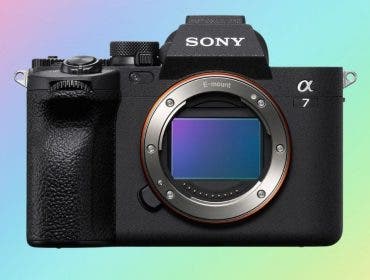There are certain situations when DSLR cameras just aren’t very convenient or practical for taking pictures. And for those situations, mirrorless cameras are a great alternative option. They still allow you to take crisp, high-quality photos, change lenses according to your needs, and do a lot of other things that you can do with a DSLR—but in a lighter and more portable package.
Sony is one of the best when it comes to mirrorless cameras, and it has a wide selection to choose from, including the newer Sony A6300 and the older full-frame Sony A7.
What’s the difference between the Sony A6300 and the Sony A7?
Both are 24-megapixel mirrorless cameras, and their technical specifications are somewhat similar. The biggest difference between the two is the sensor within each camera—the Sony A6300 has an APS-C sensor, while the Sony A7 has a 35mm full-frame sensor.
Sony A6300 vs. Sony A7 specifications
| Camera Specs | Sony A6300 | Sony A7 |
| Sensor | APS-C (23.5 x 15.6 mm) Exmor® CMOS sensor | 35mm full-frame (35.8×23.9 mm), Exmor® CMOS sensor |
| Mount | Sony E-mount | Sony E-mount |
| Number of pixels | 24.2 megapixels | 24.3 megapixels |
| ISO sensitivity | ISO 100 – 51200 | ISO 100 – 25600 |
| Speed (frames per second) | 11 fps continuous mode | 5 fps continuous mode |
| Video resolution | 3840 x 2160 | 1920 x 1080 |
| Weight (body) | 12.73 oz | 14.67 oz |
| Price | $998.00 | $1,098.00 |
Advantages of the Sony A7 over the Sony A6300
Larger Sensor
The Sony A7 is equipped with a 35mm full-frame sensor, while the Sony A6300 has a crop sensor. This means that the Sony A7 has a larger sensor, which has many advantages over regular APS-C crop sensors—like higher image quality, wider angles, smaller depth of field, and more.
Faster Maximum Shutter Speed
The maximum shutter speed for the A7 is 1/8000 seconds, which is significantly faster than the A6300’s 1/4000. Faster shutter speeds are used to eliminate motion blur, freeze movement, etc.
Higher Effective ISO
The Sony A7 has a higher effective ISO than the A6300 (2,248 vs 1,437 ISO), which translates to reduced noise in low-light photos.
Headphone Port
For those who want to shoot video on their mirrorless camera, the Sony A7 is equipped with a headphone port that allows monitoring audio while simultaneously shooting videos.
Advantages of the Sony A6300 over the Sony A7
Budget-Friendly
As it’s not a full-frame camera, Sony A6300 is the cheaper of the two. At Adorama, the A6300 is about $100 cheaper than the A7.
Higher Video Resolution
The ability to shoot high-quality 4K (UHD) videos is one of the most significant advantages of the Sony A6300 over the Sony A7, which shoots only full HD 1920 x 1080 videos. The A6300 also records in both AVCHD and XAVC S formats, while the A7 records only in AVCHD.
Faster Autofocus and More Focus Points
With 425 autofocus (AF) points, the A6300 has 300 more than the A7. Having more AF points is ideal for those who shoot scenes with a lot of motion—such as in sports or wildlife photography. Unlike its predecessors, the A6300 boasts of faster autofocus at 0.05 seconds.
Faster Shooting in Burst Mode
When shooting in burst mode, the A6300 is significantly faster. It shoots 11 fps, which is a lot faster compared to the A7’s 5 fps.
Built-In Flash
The Sony A6300 has an internal flash, which can be handy when you have no other source of artificial light in low-light situations.
Longer Battery Life
You get a little bit more battery life out of the A6300, with approximately up to 350 shots (viewfinder) or 400 shots (LCD screen) when shooting still images. Meanwhile, the Sony A7 can take up to 340 shots.
Lighter Weight
The Sony A6300 is nearly 2 oz or 56.67 g lighter than the A7. Since the latter is equipped with a full-frame sensor, the actual camera body has to be bigger and heavier than its crop sensor counterparts to accommodate the larger sensor.
Common Strengths of the Sony A6300 and Sony A7
- Articulating Screen – LCD screen can be tilted for added shooting flexibility
- Focus Peaking – camera automatically highlights elements that are in focus
- Built-in Wi-Fi and NFC – better connectivity
- RAW Support – allows shooting in RAW for higher image quality
- Eye Autofocus – extremely accurate eye detection allows for easier and faster focusing when shooting human subjects
- Auto (AE) Bracketing – useful for HDR photography or when shooting in difficult lighting conditions
- Environmental Sealing – enhanced durability
- Multi Interface Shoe – allows attachment of external flash





